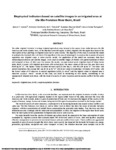Use este identificador para citar ou linkar para este item:
http://www.alice.cnptia.embrapa.br/alice/handle/doc/1055654Registro completo de metadados
| Campo DC | Valor | Idioma |
|---|---|---|
| dc.contributor.author | LEIVAS, J. F. | pt_BR |
| dc.contributor.author | TEIXEIRA, A. H. de C. | pt_BR |
| dc.contributor.author | SILVA, G. B. S. da | pt_BR |
| dc.contributor.author | RONQUIM, C. C. | pt_BR |
| dc.contributor.author | REIS, J. B. R. da S. | pt_BR |
| dc.date.accessioned | 2016-10-31T11:11:11Z | pt_BR |
| dc.date.available | 2016-10-31T11:11:11Z | pt_BR |
| dc.date.created | 2016-10-31 | pt_BR |
| dc.date.issued | 2016 | pt_BR |
| dc.identifier.citation | Proceedings of SPIE - International Society for Optical Engineering, v. 9998, p. 99981N-1-99981N-9, 2016. | pt_BR |
| dc.identifier.uri | http://www.alice.cnptia.embrapa.br/alice/handle/doc/1055654 | pt_BR |
| dc.description | The Jaíba Irrigated Perimeter is a large irrigated agriculturearea, located in the region Forest Jaíba between the SãoFrancisco and Verde Grande rivers, in the Brazilian semi-arid region. In 2014, irrigators thisthe region face losses in theinterruption of new plantings in irrigated areas due to water scarcity. The objective ofthis study is combine the modelto estimate the Monteith BIO with the SAFER algorithm in the case of obtaining ET, to analyze the dynamics of naturalvegetation and irrigated crops in water scarcity period. For application of the model are necessary data frommeteorological stations and satellite images. Were used 23satellite images of MODIS withspatial resolution of 250mand temporal 16 days, of 2014 year. For analyze the results,we used central pivots irrigation mask of Minas Geraisstate, Brazil. In areas with irrigated agriculture with central pivot, the mean values of BIO over the year 2014 were88.96 kg.ha-1.d-1. The highest values occurred between April 23 and May 8, with BIO 139 kg.ha-1.d-1. For areas withnatural vegetation, the average BIO was 88.34 kg.ha-1.d-1with lower values in September. Estimates of ET varied withthe lowest values of ET observedin natural vegetation 1,91±1,22 mm.d-1and the highest values in irrigated area isobserved 3,51±0,97 mm.d-1. Results of this study can assist in monitoring of river basins, contributing to themanagement irrigated agriculture, with the trend of scarcity of water resources and increasing conflicts for the wateruse. | pt_BR |
| dc.language.iso | eng | eng |
| dc.rights | openAccess | eng |
| dc.subject | Irrigated area | pt_BR |
| dc.subject | SAFER | pt_BR |
| dc.subject | Área irrigada | pt_BR |
| dc.title | Biophysical indicators based on satellite images in an irrigated area at the São Francisco River Basin, Brazil. | pt_BR |
| dc.type | Artigo de periódico | pt_BR |
| dc.date.updated | 2017-05-18T11:11:11Z | pt_BR |
| dc.subject.thesagro | Biomassa | pt_BR |
| dc.subject.thesagro | Evapotranspiração | pt_BR |
| dc.subject.nalthesaurus | biomass | pt_BR |
| dc.subject.nalthesaurus | evapotranspiration | pt_BR |
| riaa.ainfo.id | 1055654 | pt_BR |
| riaa.ainfo.lastupdate | 2017-05-18 | pt_BR |
| dc.contributor.institution | JANICE FREITAS LEIVAS, CNPM; ANTONIO HERIBERTO DE C TEIXEIRA, CNPM; GUSTAVO BAYMA SIQUEIRA DA SILVA, CNPM; CARLOS CESAR RONQUIM, CNPM; João Batista Ribeiro da Silva Reis, EPAMIG. | pt_BR |
| Aparece nas coleções: | Artigo em periódico indexado (CNPM)  | |
Arquivos associados a este item:
| Arquivo | Descrição | Tamanho | Formato | |
|---|---|---|---|---|
| PaperBiophysicalJaniceSPIE16.pdf | 1,19 MB | Adobe PDF |  Visualizar/Abrir |









